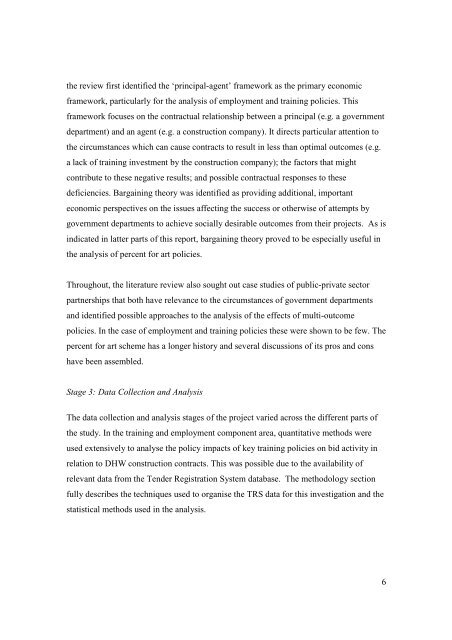Multi Outcome Construction Policy (final report)
Multi Outcome Construction Policy (final report)
Multi Outcome Construction Policy (final report)
You also want an ePaper? Increase the reach of your titles
YUMPU automatically turns print PDFs into web optimized ePapers that Google loves.
the review first identified the ‘principal-agent’ framework as the primary economicframework, particularly for the analysis of employment and training policies. Thisframework focuses on the contractual relationship between a principal (e.g. a governmentdepartment) and an agent (e.g. a construction company). It directs particular attention tothe circumstances which can cause contracts to result in less than optimal outcomes (e.g.a lack of training investment by the construction company); the factors that mightcontribute to these negative results; and possible contractual responses to thesedeficiencies. Bargaining theory was identified as providing additional, importanteconomic perspectives on the issues affecting the success or otherwise of attempts bygovernment departments to achieve socially desirable outcomes from their projects. As isindicated in latter parts of this <strong>report</strong>, bargaining theory proved to be especially useful inthe analysis of percent for art policies.Throughout, the literature review also sought out case studies of public-private sectorpartnerships that both have relevance to the circumstances of government departmentsand identified possible approaches to the analysis of the effects of multi-outcomepolicies. In the case of employment and training policies these were shown to be few. Thepercent for art scheme has a longer history and several discussions of its pros and conshave been assembled.Stage 3: Data Collection and AnalysisThe data collection and analysis stages of the project varied across the different parts ofthe study. In the training and employment component area, quantitative methods wereused extensively to analyse the policy impacts of key training policies on bid activity inrelation to DHW construction contracts. This was possible due to the availability ofrelevant data from the Tender Registration System database. The methodology sectionfully describes the techniques used to organise the TRS data for this investigation and thestatistical methods used in the analysis.6
















